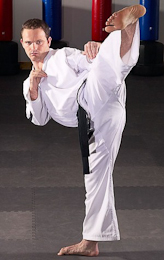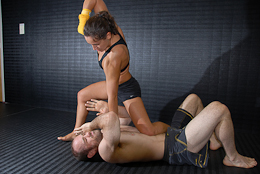Martial Arts Workout
Martial arts were originally developed to teach people how to defend themselves against physical threats. Though the martial arts originated in Asia, they are presently practiced around the world with 1.5 million Americans participating currently. Today martial arts are used for not only self defense but, as an exercise type to improve cardiovascular endurance, muscular strength, balance, flexibility, coordination, and self-confidence. Though the muscles used most in martial arts depend on the form being used, most of the muscles groups are used to some degree. The most common muscles are the deltoids, abs, hamstrings, pectorals, biceps, triceps, quadriceps, hips, gluteus maximus, and calf muscles. Loose fitting clothing is highly recommended for practicing martial arts. Many forms of martial arts have specific clothing associated with them which should be worn. Some forms of martial arts require weaponry as well. Facemasks should be used for protection when sparring with another person. Leg stretchers, shields, hanging bags, targets, boards, and mats can all be used as well. Cost: $50 to $100 per month and $25 to $100 for supplies Martial arts classes typically cost $50 to $100 per month, while clothing and specialized equipment (depending on your chosen style) can incur additional costs. Activity Locations: Class At least at first, martial arts should be practiced in a class setting. Intricate movements and discipline taught in martial arts classes with be critical to your success. Types of MovementsThere are numerous different styles of martial arts. Boxing is a style developed in the west which mainly utilizes punching. Wing Chun also uses punching as its primary focus. Savate and Capoeira primarily focus on kicking. Tai Kwon Do, Kickboxing, Kung Fu, Karate, and Murry Thai all use other body parts such as open hands, elbows, and knees as a primary focus. Judo, Glima, Jujutsu, and Sambo utilize throwing. Judo and Wrestling also use techniques to pin the opponent to the ground. A joint lock, which is when the opponent's limb is locked in a position equal to its maximum range of motion, is used in Aikido, Brazilian Jiu-jitsu, and Hapkido. Weapons are utilized in Fencing, Gatka, Kendo, and Shooting Sports. Although the former lists only the primary focus of the forms of many common martial arts, it should be noted that other techniques can be learned from them as well. The field of martial arts is not limited to these styles. There are many others that have not been mentioned. Mental and Physical RequirementsAlthough you might assume that martial arts requires only peak physical condition, there are many style of martial arts suitable for all ages and body types. Most fitness centers offer classes for different ages and types of people, especially larger gyms. The same rules for participating in any physical activity apply to martial arts -- seek approval from a medical professional before enrolling in martial arts classes, especially if you are overweight or over the age of 55. Equipment Requirements
Mental and Physical BenefitsMental
Physical
Aerobic Effect
Performing a martial arts exercise workout can create an aerobic effect but are generally practiced in a way in which the heart rate is not elevated to it's target heart rate for at least 20 consecutive minutes. In these situations performing a martial arts routine would be considered anaerobic. termite treatment specialists Moreno Valley CA Psychologically, martial arts can be very useful in learning discipline and balance.The deep breathing used in some forms of martial arts can be used to treat hypertension and relieve stress. Blood pressure can decrease and the risk of cardiovascular disease can lessen through regularly practice some form of martial arts. Oxygen intake has been shown to increase in some patients in a study by 20%. It can also decrease the body's level of Cortisal which in turn reduces the blood sugar level, reduces fatigue, and can help with weight loss. |
Copyright © 2025 FitnessHealth101.com All Rights Reserved
FITNESS TOPICS
FITNESS REVIEWS
FITNESS & HEALTH GLOSSARIES

